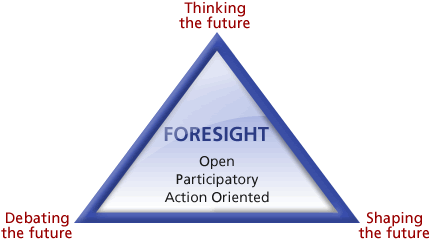Foresight is a systematic, participatory, future-intelligence-gathering and medium-to-long-term vision-building process aimed at enabling present-day decisions and mobilizing joint actions. It can be envisaged as a triangle combining “Thinking the Future”, “Debating the Future” and “Shaping the Future”. Foresight is neither prophecy nor prediction. It does not aim to predict the future – to unveil it as if it were predetermined – but to help us build it. It invites us to consider the future as something that we can create or shape, rather than as something already decided.
Source: JRC-IPTS
Action-oriented
Foresight is not only about analysing or contemplating future developments but supporting actors to actively shape the future. Purely analytical studies of possible futures (i.e. “futures studies”) without connection to possible actions are not considered as Foresight. Therefore, Foresight activities should only be undertaken when it is actually possible to shape the future.
Open to alternative futures
Foresight assumes that the future is not pre-determined. The future can therefore evolve in different directions, which can be shaped to some extent by the actions of various players and the decisions taken today. In other words, there is a certain degree of freedom to choose among the alternative, feasible futures, and hence increase the chance of arriving at the preferred (selected) future state.
Participatory
Foresight is not done by a small group of experts or academics but involves a number of different groups of actors concerned with the issues at stake. The results of the Foresight exercise are disseminated among a large audience from which feedback is actively sought.
Multidisciplinary
Foresight is based on the principle that the problems we face cannot be correctly understood if reduced to one dimension and sliced up like salami to allow it to fit into the perspective of the different academic disciplines. Instead, Foresight provides an approach that captures realities in their totality with all the variables influencing them, regardless of the type (quantitative and qualitative).
